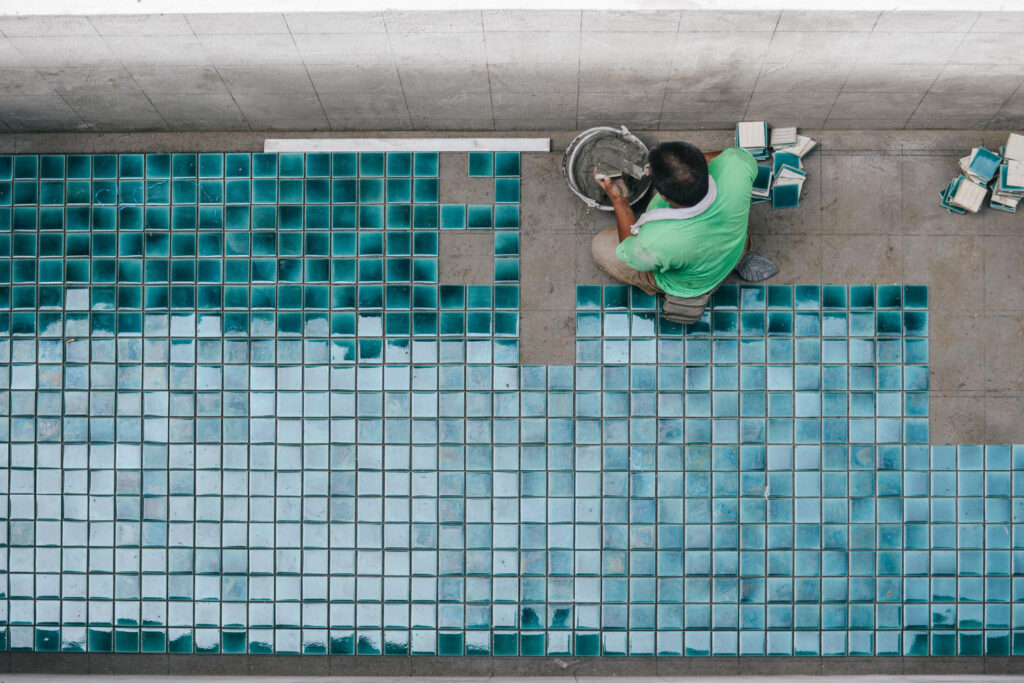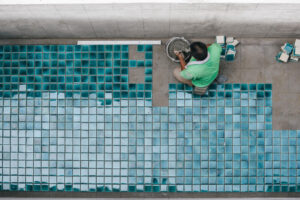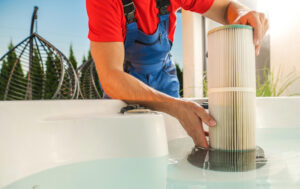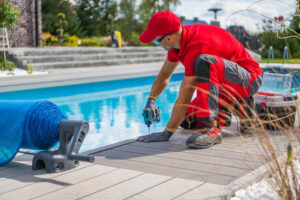Your pool is supposed to be a source of relaxation and fun, but time and weather can take their toll on even the best-built pools. We’ll help you identify the key warning signs that indicate it’s time to make a pool renovation, from visible cracks and structural damage to outdated features that affect safety and enjoyment.
Understanding when to upgrade can save you money and prevent small problems from becoming major headaches. Pool renovation doesn’t always mean starting over completely.
We’ll walk you through the difference between remodeling and rebuilding, what you can expect from professional repair services, and how to choose finishes that will last for years to come.
Through the topics below, you’ll learn how to protect your investment and enhance your backyard experience:
- Pool remodeling vs. starting from scratch
- What to expect from a high-end pool repair service
- Customizing your renovation with lasting finishes
- Understanding pool renovation costs and timelines
Whether you’re dealing with persistent leaks, outdated equipment, or simply want to modernize your backyard oasis, knowing the right time to act is crucial.
Signs your pool is ready for a renovation
Your pool will show clear warning signs when it needs major work. Visible damage like cracks and stains, inefficient equipment that drives up costs, and outdated designs are the main indicators that renovation time has arrived.
Surface cracks, stains, and outdated finishes
Visible cracks are the most obvious sign we need swimming pool resurfacing. Small hairline cracks can grow into major structural problems. Large cracks allow water to leak out and damage the pool’s foundation.
Stubborn stains that won’t come off with regular cleaning show the pool finishes are failing. These stains make the pool look dirty even when it’s clean. Algae stains that keep coming back also signal surface problems.
Rough or chalky surfaces mean the finish is breaking down. We might feel sharp edges when walking on pool decks. The pool walls may feel gritty instead of smooth.
Common finish problems include:
- Plaster deterioration – white chalky residue in water
- Tile damage – loose or missing tiles around waterline
- Faded surfaces – original colors look dull or patchy
- Etching marks – permanent white spots from chemical imbalance
When these issues appear, regular swimming pool repair won’t fix them. We need complete resurfacing to restore the pool’s appearance and function.
Equipment inefficiency and rising maintenance costs
The EPA estimates that evaporation, filter backwashing, and mineral buildup account for approximately 56%, 23%, and 21%, respectively, of water use in commercial pools—highlighting why investing in renovation and modern maintenance systems helps reduce costly water loss.
Higher energy bills often signal aging pool equipment. Old pumps and heaters use much more electricity than newer models. We might see our utility costs double compared to efficient systems.
Frequent breakdowns mean equipment is reaching the end of its life. When we’re calling repair technicians monthly, replacement becomes more cost-effective than constant fixes.
Chemical imbalances that are hard to control indicate circulation problems. Poor water flow creates dead spots where bacteria grow. We end up using more chemicals to maintain safe swimming conditions.
Warning signs of equipment failure:
- Pump runs constantly but water stays cloudy
- Heater takes much longer to warm pool
- Filter needs cleaning every few days
- Automatic cleaners stop working properly
Rising pool maintenance costs add up quickly. When we spend more on repairs than a new system would cost, renovation makes financial sense. Modern equipment often pays for itself through energy savings.
Design that no longer fits your lifestyle or home
Outdated aesthetics make pools look old-fashioned. Design trends from the 1980s and 1990s now appear dated. We might have bright blue tiles or geometric shapes that clash with modern home styles.
Poor functionality affects how we use the pool. Shallow depths limit swimming activities. Missing features like built-in seating or swim-up bars reduce entertainment value.
Safety concerns become more important as families change. We need better lighting for evening use. Older pools often lack proper barriers or slip-resistant surfaces.
Space utilization problems develop over time. The pool might take up too much yard space. We could need more deck area for furniture and gatherings.
Common design issues include:
- Insufficient lighting for night swimming
- Limited seating around pool edges
- Poor traffic flow between pool and house
- Lack of shade structures or landscaping
When the pool no longer matches our lifestyle or home’s appearance, renovation can transform it into a better fit. We can update both looks and function to meet current needs.
Pool remodeling vs. starting from scratch
Pool remodeling typically costs 30-50% less than building new, while precast pool renovation offers faster completion times and enhanced durability for aging pools.
Is it cheaper to remodel a pool or build a new one?
Pool remodeling costs significantly less than new construction. We typically see remodeling projects range from $15,000 to $35,000, while new pool installation costs start at $50,000 and can exceed $100,000.
The exact savings depend on your current pool’s condition. Surface repairs like new plaster or tile work cost much less than structural changes.
Major cost factors include:
- Structural work: Foundation repairs add substantial costs
- Equipment upgrades: New pumps, heaters, and filtration systems
- Design changes: Expanding pool size requires excavation work
- Permits: Remodeling typically needs fewer permits than new builds
We recommend remodeling when your pool structure remains sound. Cracked foundations or major plumbing issues may justify new construction instead.
When renovation offers better long-term value
Swimming pool renovation provides better long-term value when done strategically. We see the highest returns on energy-efficient equipment upgrades and safety improvements.
For example, according to Energy.gov, installing an energy-efficient pool heater and using a pool cover can cut pool heating and energy costs by 50–70%, making renovation efforts with upgraded equipment financially worthwhile.
Modern pool systems reduce operating costs by 40-60% annually. LED lighting, variable-speed pumps, and automated controls pay for themselves within 3-5 years.
High-value renovation projects include:
- Resurfacing: Extends pool life by 10-15 years
- Equipment modernization: Reduces monthly utility bills
- Safety upgrades: Adds property value and peace of mind
- Aesthetic improvements: Increases home resale value
We suggest avoiding renovation when repair costs exceed 60% of new construction costs. Pools over 25 years old with multiple system failures often benefit more from replacement.
How precast pool renovation modernizes with ease
Precast pool renovation offers faster installation and superior durability. We complete most precast renovations in 2-3 weeks compared to 6-8 weeks for traditional methods.
Precast panels resist cracking better than poured concrete. They maintain structural integrity in freeze-thaw cycles and ground movement.
Key advantages of precast renovation:
- Speed: Factory-made components install quickly
- Quality: Controlled manufacturing reduces defects
- Flexibility: Multiple design options available
- Longevity: 20-30 year expected lifespan
We use precast systems to update pool design without complete reconstruction. The process involves installing new precast walls over existing structures, then adding modern finishes and equipment.
This method works best for rectangular and geometric pool shapes. Freeform pools may require custom fabrication or alternative renovation approaches.
What to expect from a high-end pool repair service
High-end pool repair services offer comprehensive solutions that go beyond basic fixes. They provide expert assessment, quality materials, and skilled craftsmanship that can transform simple repairs into complete pool upgrades.
What qualifies as swimming pool repair vs. renovation
Swimming pool repair focuses on fixing specific problems with existing components. This includes patching cracks, replacing broken tiles, or repairing pool equipment like pumps and filters.
Pool renovation involves major changes to the pool’s structure, design, or functionality. We classify renovation as projects that require permits, structural modifications, or complete system overhauls.
Common Pool Repairs:
- Crack repairs in concrete or plaster
- Tile replacement
- Equipment maintenance
- Leak detection and sealing
- Filter system fixes
Pool Renovation Projects:
- Complete resurfacing
- Adding water features
- Expanding pool size
- Installing new decking
- Upgrading electrical systems
The line between repair and renovation often blurs. A simple crack repair might reveal structural issues that require extensive work. Professional pool contractors can assess whether your project needs basic fixes or full renovation.
Working with a pool repair you can trust
Finding reliable pool repair requires research and careful selection. We recommend checking licenses, insurance, and local references before hiring any pool contractor.
Key Qualifications to Verify:
- Active contractor’s license
- Liability insurance coverage
- Workers’ compensation insurance
- Better Business Bureau rating
- Local customer reviews
Professional pool service companies provide detailed estimates before starting work. They explain the repair process, timeline, and costs upfront. Quality contractors offer warranties on their work and use industry-standard materials.
Local pool contractors understand regional climate challenges and building codes. They stock common replacement parts and can respond quickly to urgent repairs. We suggest getting multiple quotes for major repairs to compare pricing and approaches.
Established companies maintain ongoing relationships with customers. They provide regular maintenance services and can spot potential problems early. This prevents small issues from becoming expensive repairs later.
How Little Dipper elevates basic fixes into full transformations
Little Dipper approaches pool repairs with a renovation mindset. We assess each repair within the context of the entire pool system to identify improvement opportunities.
When we fix a cracked pool surface, we evaluate the overall condition of the pool finish. This allows us to recommend complementary upgrades that enhance both function and appearance.
Our Transformation Process:
- Complete pool system assessment
- Identification of related upgrade opportunities
- Presentation of repair and enhancement options
- Coordinated project timeline
- Quality assurance throughout the process
We combine necessary repairs with aesthetic improvements. A simple equipment repair might include upgrading to energy-efficient systems. Tile repairs can become opportunities to modernize the pool’s appearance.
Our skilled craftsmen use premium materials that exceed industry standards. We source durable finishes, advanced equipment, and attractive design elements that add long-term value to your pool.
Little Dipper’s comprehensive approach means fewer future service calls. We address underlying issues during repairs rather than applying temporary fixes. This saves you money and extends your pool’s lifespan.
Customizing your renovation with lasting finishes
The right finishes and features can transform your pool from outdated to stunning while adding years of durability. Modern surfacing materials, smart technology, and thoughtful landscape integration create a cohesive outdoor space that enhances your property value.
Tile, plaster, and modern surfacing options
Traditional plaster remains a popular choice for pool finishes. Standard white plaster costs less upfront but typically lasts 7-10 years before needing replacement.
Aggregate finishes offer superior durability and visual appeal. These options include:
- Pebble finishes – Natural stones create texture and last 15-20 years
- Quartz finishes – Crushed quartz provides smooth surfaces with sparkle
- Glass bead finishes – Recycled glass creates unique color effects
Pool tiles add elegance and longevity to your renovation. Porcelain tiles resist fading and chemical damage better than ceramic options. Glass tiles reflect light beautifully but require more maintenance.
Modern surfacing options include polished aggregate and exposed aggregate finishes. These materials resist staining and provide slip-resistant surfaces around pool decks.
We recommend choosing finishes based on your climate, usage patterns, and maintenance preferences. Darker colors absorb more heat, while lighter shades stay cooler in direct sunlight.
Integrating new lighting and smart automation
LED pool lighting transforms your pool into a nighttime focal point. These energy-efficient lights last 25,000 hours and come in multiple colors. Underwater lights highlight water features, while perimeter lighting ensures safety.
Smart pool automation systems control heating, filtration, and chemical balance remotely. Popular features include:
- Automated chemical dosing – Maintains proper pH and chlorine levels
- Variable speed pumps – Reduce energy costs by 70-90%
- Smart thermostats – Heat your pool before you arrive home
- Mobile app controls – Monitor and adjust settings from anywhere
Lighting automation creates custom scenes for different occasions. We can program gentle lighting for evening swims or bright illumination for pool parties.
Integration costs vary widely based on system complexity. Basic LED upgrades start around $500, while comprehensive smart systems can exceed $5,000. However, energy savings often offset initial investments within 2-3 years.
Creating a seamless blend with your landscape
Landscape integration makes your renovated pool feel like a natural part of your outdoor space. We focus on materials, plants, and design elements that complement your pool finishes.
Hardscape coordination ensures your pool deck, walkways, and retaining walls work together visually. Natural stone coping pairs well with aggregate finishes, while modern concrete suits sleek tile designs.
Plant selection affects both aesthetics and maintenance. We avoid plants that drop excessive leaves or attract bees near swimming areas. Drought-resistant options like ornamental grasses and succulents reduce water usage.
Water features create focal points and mask neighborhood noise. Spillover spas, fountains, and waterfalls integrate naturally with landscape design when planned together.
Outdoor living spaces extend your pool’s usability. Fire pits, outdoor kitchens, and seating areas create year-round gathering spots that complement your pool renovation.
Drainage planning prevents water damage to both your pool and surrounding landscape. Proper grading directs runoff away from pool equipment and plant beds.
Understanding pool renovation costs and timelines
Pool renovation costs vary widely based on the project scope, materials chosen, and timeline requirements. Most homeowners spend between $5,000 and $50,000 on pool renovations, with timelines ranging from 1-8 weeks depending on complexity.
How much does it cost to renovate a pool?
Basic pool resurfacing typically costs between $5,000 and $15,000 for standard materials like plaster or pebble finishes. More extensive renovations that include tile work, coping replacement, and equipment upgrades can reach $25,000 to $50,000.
Basic Renovation Costs:
- Pool resurfacing: $5,000 – $15,000
- Tile replacement: $2,000 – $8,000
- Coping repair: $1,500 – $5,000
- Equipment upgrades: $3,000 – $12,000
Full pool remodels with structural changes, new water features, or premium finishes can exceed $75,000. We recommend getting quotes from multiple contractors to understand the true cost for your specific project.
The size of your pool directly impacts costs. Larger pools require more materials and labor hours, increasing overall expenses.
The real value behind quality materials and expert work
Quality materials cost more upfront but provide better durability and appearance over time. Premium plaster finishes last 15-20 years compared to 8-12 years for basic options.
Material Longevity:
- Basic plaster: 8-12 years
- Quartz aggregate: 12-15 years
- Pebble finishes: 15-20 years
- Glass tile: 20+ years
Expert installation ensures proper surface preparation and application techniques. Poor workmanship can lead to early failure, requiring costly repairs within just a few years.
We’ve seen homeowners save money initially with cheaper materials, only to face expensive repairs much sooner than expected. Professional contractors also provide warranties that protect your investment.
What impacts the cost to resurface a swimming pool?
Pool condition significantly affects resurfacing costs. Pools with structural damage or extensive repairs need additional work before new surfaces can be applied.
Cost Factors:
- Pool size and shape
- Current surface condition
- Material selection
- Geographic location
- Contractor availability
Complex pool shapes with curves or custom features require more labor and materials. Simple rectangular pools cost less to resurface than freeform designs.
Geographic location affects both material and labor costs. Areas with higher living costs typically see increased renovation expenses.
Contractor availability impacts both cost and timeline. Busy seasons may result in higher prices and longer wait times for project completion.
Conclusion
Pool renovation doesn’t have to be overwhelming when you know what to look for. We’ve covered the key signs that indicate it’s time for a makeover.
The best time to renovate is during fall and winter months. This timing lets you avoid peak swimming season disruptions.
Your pool is a major investment in your home. Regular maintenance helps extend its life, but renovation becomes necessary over time.
We recommend getting professional quotes when you notice multiple warning signs. Expert contractors can assess your pool’s condition and suggest the right upgrades.
Don’t wait until problems become serious. Small issues often turn into costly repairs if ignored.
The right renovation transforms your pool into a safe, beautiful space your family can enjoy for years. Whether you need simple resurfacing or a complete makeover, taking action at the right time protects your investment.
Schedule a professional pool renovation consultation with Little Dipper today to restore performance, safety, and style to your outdoor space.






